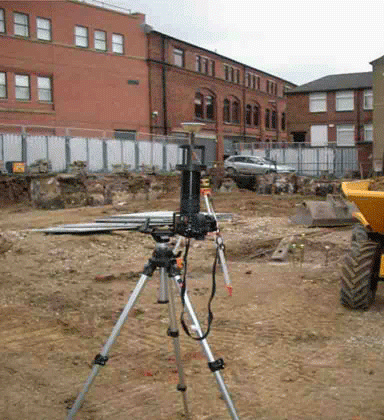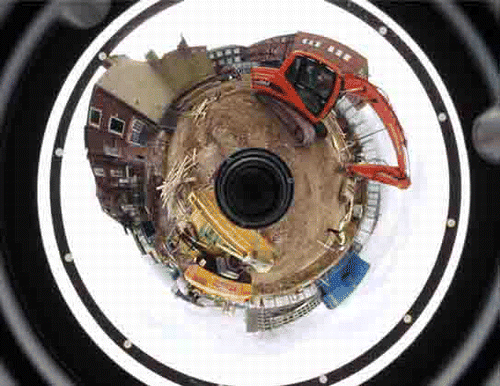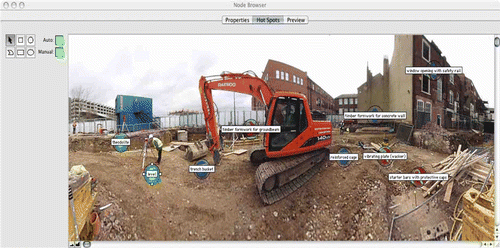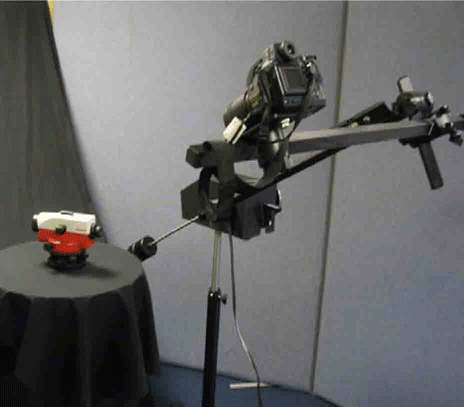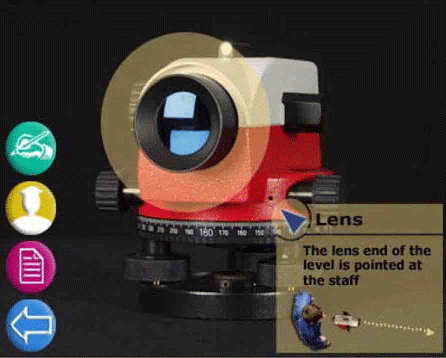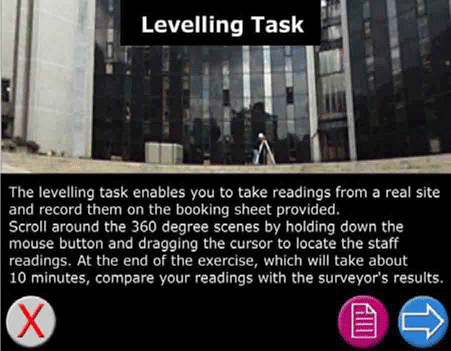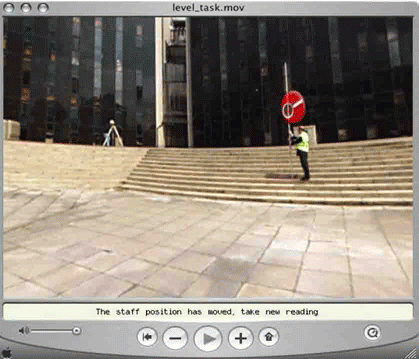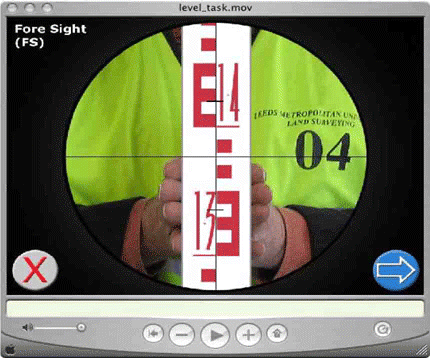Abstract
Information technology has the potential not only to remove perceived barriers to learning traditionally associated with off-site study, but also to enhance the quality of educational experience for all students. Adopting a case study methodology, a range of innovative multimedia technologies are used, in particular QuickTimeVR panoramas, to create photo-realistic construction environments. The paper draws upon an award-winning National Teaching Fellowship project, Virtualsite, to evaluate techniques for producing photo-realistic tours of construction sites and to explore new ways of embedding learning objects within panoramas. A novel interface is created, which allows access to a range of media e.g. digital photographs, video, sound, multi-row object movies, and interactive student assessments.
Consistent with the industry’s move towards a collaborative ethos, the production of high quality media-rich learning resources relies on the contribution of all stakeholders: academics, practitioners and professional institutions. Virtualsite is currently being used in a variety of education settings and, importantly, may have other applications in industry. The paper concludes that mutual benefit can be derived from the development of these technologies and, consistent with the philosophy underpinning Learning Objects, that greater sharing of resources will enhance both the quality and breadth of materials available to students.
Introduction
The UK construction industry employs approximately 2 million people (CitationCITB, 2005) and makes a major contribution to the UK economy and society — the Construction Industry Council (CIC) and the Department of Trade and Industry (DTI), for example, estimate that the work of engineers, surveyors, architects and other consultants contributes 1.4% of the UK’s GDP. The CITB report Managing Profitable Construction (Citation2000) states that construction companies whose employees have higher skills “make more money, complete more projects on time and have more satisfied clients”. This view is widely accepted by leading industry bodies such as Constructing Excellence and the Movement for Innovation (M4I), by government supported initiatives such as the University for Industry and the Investors in People standard, and by Higher Education Institutions (HEIs). However, CitationSir John Egan’s Skills Review (2004) highlights the need to bridge the gap between the current skills base and the skills needed for the creation of prosperous sustainable communities:
People are very clear about what they want from their communities — places which are safe, clean, friendly, and prosperous, with good amenities such as education, health services, shopping and green spaces … But in too many places our current approach and systems are failing to deliver what people want … To turn things around we need a common goal, a clear understanding of the sort of communities we are trying to achieve … and above all skilled committed individuals working together to make people’s priorities a reality.
Egan’s views should have come as little surprise to the industry, as two years earlier his report Accelerating Change (2002) identified the quantum of this deficiency and set out recruitment targets to overcome the shortfall i.e. to recruit and retain 300,000 qualified people by the end of 2006, requiring a 50% increase in suitable applications to built environment higher and further education courses by 2007.
Whilst Egan does not subscribe to the view that construction projects are unique, it is widely acknowledged that project teams are ephemeral i.e. they are comprised of bespoke combinations of organisations variously located around the UK for limited periods of time. Consequently, experienced practitioners find it difficult to sustain traditional study patterns. There has been a growth in postgraduate education in some construction-related disciplines e.g. RICS approved courses, but a survey conducted by CitationEllis et al. (2003) found that cohorts were often small and that there was little evidence of successful flexible provision in the sector. Indeed they concluded that a culture of lifelong learning had not been established in the industry. Today, however, there are signs that Managed Learning Environments (MLEs) are beginning to offer HEIs a new and potentially valuable mechanism for increasing outreach.
This paper examines the issues encountered during the development of an on-line learning environment, which adopts a virtual construction site metaphor as the interface for providing access to a range of media-rich learning resources to both full-time and distance learning students.
Learning Objects
Off-campus learning presents many challenges for learners and tutors alike. The former require discipline, enthusiasm and commitment to complete their studies (CitationEllis and Thorpe 2004), whilst the latter are charged with the development of learning resources that intrinsically motivate students. Distance learning theory (e.g. CitationHolmberg, 1999; Moore, 2002), and the developing international quality standards of on-line learning are helpful in providing principles of good practice. It is clear that distance learning materials must be of high quality and engage the student. Information technology offers the potential to provide a diverse range of learning resources, although CitationGarbett (2004) recommends caution before proceeding to develop distance learning courses, as the cost implications of creating a media-rich on-line learning experience for distance learning students can be significant. Hence it is no surprise to find that the concept of Learning Object repositories, which promote sharing and collaboration, is attracting considerable interest. Many examples exist e.g. Merlot and Wisc-online, and activity in the construction sector is increasing — the Centre for Education in the Built Environment (CEBE), providing a catalyst via the e-Learning in the Built Environment’s Special Interest Group (SIG).
Whilst there is much debate regarding the meaning of the term Learning Object, Wiley’s simple definition i.e. “any [digital or non-digital] resource that can be re-used to support learning” (CitationWiley, 2001, p. 4) is helpful. Equally welcome is the emphasis that Wiley places on instructional theory and his refreshing approach to pedagogic underpinning. If Learning Objects are to be used as something more than “clip art instruction”, he believes that the twin issues of combination i.e. sequencing Learning Objects in such a way that makes instructional sense, and granularity i.e. deciding upon the size of a Learning Object, must be addressed. Certainly there is need to advance our understanding of Learning Objects and pursue research in instructional design, as the educational merit of Learning Objects is not uncontested. CitationBurton (2003) neatly summaries these concerns in his paper Learning Objects: Weapons of Mass Instruction, where he raises two searching questions:
Is it possible to create Learning Objects aimed at engaging learners to grasp how to think rather than what to think, or to allow them to think for themselves?
Can Learning Object Systems enhance creativity and inventiveness?
Methodology
The questions posed by Burton (ibid) are the key challenges which Virtualsite, the case study upon which this paper is based, attempts to address. Commencing in September 2003, Virtualsite is a three-year project funded by the National Teaching Fellowship Scheme (NTFS), which houses a range of learning resources available to schools, undergraduate students and academic staff. Drawing on the concept of a Learning Object repository, extensive use is made of photo-realistic imagery to:
Challenge youngsters’ preconceptions of a career in construction;
Simulate a “real-life construction environment; and
Strengthen links between industry, academia and allied professional bodies.
Clearly, these aims are ambitious, perhaps overly so, but they have allowed educational technologists the scope to design innovative learning resources, to evaluate alternative methods for creating interactivity and to embed Learning Objects (or products) within the academic curriculum. As David CitationArchibald (2001) states:
Creativity + Productivity = Innovation.
CitationKerres (1995) identifies three levels of instructional design. These are at the micro-level i.e. the design of the media components, the meso-level i.e. the choice and formulation of instructional design, and the macro-level i.e. the integration of computer-aided learning in the social context of learning. Accordingly, evaluation should focus not only on the software itself but also the quality of the educational program in the context of its development and use (CitationTergan, 1998). However, Virtualsite is only part complete and much of the work at the time of writing has focused on the technological issues encountered during the development of a virtual construction site interface. Consequently this paper will report on the lessons learned during the development of photo-realistic scenes and early student reaction to this new resource.
Creating the User Interface
Virtualsite makes extensive use of QuickTimeVR technology, developed by Apple Computer Inc., to create 360 degree panoramas which viewers are able to explore. VRWorx software enhances interactivity within these scenes by enabling icons to be embedded within the image thereby providing access to a variety of Learning Objects. The concept underpinning the creation of panoramic images is not new (CitationShelbourn et al., 2003) although the steps involved in the creation of photo-realistic virtual reality systems have been greatly simplified by recent advances in hardware and software functionality.
Panoramas
Initial attempts to create 360 degree panoramas relied on taking multiple film or digital images and stitching these together using either graphic design software (e.g. Adobe Photoshop) or bespoke software packages such as Realviz Stitcher (CitationDickinson et al., 2004). Today, novel hardware attachments and accompanying photo warping software enable 360 degree panoramas to be created from either a single or two fish-eye image method. Examples include Kaidan’s 360 One VR Optic and IPIX Corporation’s immersive technology.
Choice between digital technologies and film is dependent upon a number of factors e.g. quality of output, volume and cost (CitationVRP, 2005). Similarly the costs vary between QTVR and IPIX digital photography - for low volume work QTVR technology is far more economical (ibid). Hence, the former has been used to create the scenes used in the Virtualsite project. Figures 1 and 2 show a typical panoramic tripod head set up and the donut-shaped image that it produces. PhotoWarp software transforms the image into a panoramic scene, which can be manipulated in Adobe Photoshop — inserting icons to highlight areas where viewers can access further information.
Linking scenes and objects
The enhanced jpeg image created in Adobe Photoshop is imported into VRWorx software as a Scene file together with a variety of different media e.g. panoramic movies, digital photographs and multi-row object movies. Each item that is imported into a VRWorx Scene file is known as a node and hot spots are placed over the icons to create an interactive construction scene ().
Directional sound is also inserted into the panorama using LiveStage Professional software, developed by Totally Hip Inc., to enhance the construction site experience.
Multi-row object movies
Visualisation of the construction process is a recurrent issue in built environment education (CitationFrank, 2005). QTVR object movies, therefore, provide a valuable means of gaining familiarity with construction materials and equipment. However, the processes required to produce this form of media is more arduous than its panoramic counterpart.
Each object is placed on a rotating table i.e. Kaidan’s Magellan 2000 (), and rows of images (commonly between 1 and 5 rows) are taken at 20 degree horizontal intervals. Accordingly, anywhere between 18 and 90 images may be processed in the VRWorx Object Module in order to create the illusion of a virtual object. And if the object movie is to include labels (), then extensive work must first be undertaken on each individual image in a graphic design package e.g. Adobe Photoshop. The optical level movie has four icons in each of its 90 frames, exceeding VRWorx Scene software’s stated maximum of 254 hotspots. In order to achieve this level of interactivity, it is necessary to create hotspots in the VRWorx Object Movie file. When a hotspot is copied and pasted into another frame in a VRWorx Object Movie file it becomes a clone of the original — hence the maximum number of hotspots is not exceeded.
Embedding Learning Objects in the Curriculum
The Virtualsite website holds a collection of digital images for use by staff and students. Adopting the principles enshrined in the CALVisual project (CitationBouchlaghem et al., 2000), each image adheres to a standard format i.e. size and resolution, and is catalogued in accordance with the BCIS elemental breakdown. Panoramic scenes of a traditional housing scheme and refurbishment project have been linked to create virtual construction site tours and student assessments for first year undergraduate students. This paper focuses on the latter and critically examines the potential impact on the student learning experience.
Student assessment
All first-year undergraduates studying surveying-related courses at Leeds Metropolitan University are required to identify the principles of horizontal and vertical measurement and their application in the surveying of land and buildings. Accordingly, cohorts are large (typically comprising 250 part-time and full-time students) and the assessment — comprising, in part, a practical survey using an optical level — must be completed early in the first semester of their course. The logistics associated with the delivery of this hands-on component are problematic. Supervision is resource intensive, relies on the availability of equipment and is affected by site conditions. Moreover, students who enrol late or are otherwise absent during the three weeks of supervised workshops and tutorials, receive only limited face-to-face guidance from their tutor. Hence the need to develop new approaches that simulate the practical exercise, complement existing learning resources and offer students the opportunity to gain further confidence in the operation of levelling equipment to reinforce their understanding of elementary surveying methods.
Drawing on the innovative technological developments in Virtualsite (CitationDickinson et al., 2004), students are able to navigate, via a QuickTimeVR (QTVR) panorama of a building site, to various resources, including a labelled multi-row object movie of an optical level (). From here, the user can access text-based guidance, a video showing the operation of the level or a student assessment ().
The levelling task enables students to take readings and record them on a booking sheet. Users must locate the staff in each QTVR scene (), click on the hotspot to read the staff through the viewfinder () and record the height in the appropriate booking sheet column, before proceeding to the next scene. Instructions are provided in the dialogue box within the QTVR window to clarify the nature of the reading i.e. back sight, fore sight or intermediate sight. On completion of the exercise, the readings are compared with a solution sheet and questions regarding the size of the error are raised.
Discussion
CitationChaloupka and Koppi (1998) challenge multimedia designers to create learning environments that will enable students to examine, perceive, interpret and experience information, so that they can convert information into knowledge. Moreover, they believe that interactive media will only satisfy this goal when users are given the opportunity to visualise and understand complex relationships in ways that are not possible in other media. In response to student feedback, emphasis has been placed at all stages in the design of Virtualsite media components on the creation of photorealistic imagery.
At the micro-level of instructional design QTVR has proven a qualified success. Chosen on the basis of cost, quality and compatibility, this virtual reality system has generated interactive, visually stimulating output. As such, the interface has similarities with the work of CitationHung et al. (2002) and CitationShelbourn et al. (2003) which also sought to augment panoramas with images and object movies. However, problems have been experienced on some computer platforms in playing the QTVR movies. Conflicts with Multipurpose Internet Mail Extensions (MIME) settings were unexpected and, although these have not been apparent on student platforms, academic staff still continue to experience difficulty in playing the QTVR media. Images held in the database have caused no such problem and are acknowledged as having enhanced the delivery of construction technology related modules, whilst QTVR construction site tours have been used by students within the information technology curriculum. As such, these small chunks of learning material have demonstrable value and early student reaction has been encouraging. One cohort module evaluation states:
Lively teaching style and interactive atmosphere; good variety of exercises; interesting topics; as a group we have learnt a lot of new IT skills and are pleased. The IT lessons have gone well and … presentations were of high quality.
The paper has placed particular emphasis on the development of interactive student exercises and it is here that meso-level issues have surfaced. The levelling exercise was part developed to address the needs of undergraduate students who perform similar exercises on campus. However, in formulating the instructional design, it was necessary to determine whether the resource sought to introduce theory, to reinforce student comprehension, or to replace existing hands-on activity. The latter option was dismissed on several grounds: the virtual reality system would not allow students to set up the tripod; to fully explore the functionality of the equipment e.g. turning levelling screws; or to control the position of the staff i.e. all back, intermediate and fore sights were in fixed locations. Moreover, tutors considered the absence of the touch and feel of the equipment to be an important consideration for which there was no substitute.
Conversely the ability of VRWorx software to place instructions and feedback in the QuickTime dialogue box allowed students to use the exercise as an introduction to the topic and as reinforcement following their practicals. Two versions of the exercise were created. The first provided detailed instructions and prompts for students, schooling them through the process and ensuring that they correctly enter the readings in the booking sheet. In the second version, users received little guidance and had greater scope to make booking errors.
Evaluation of Virtualsite learning resources thus far has been confined to end-of-course questionnaires. Whilst this approach is reportedly the most frequently used by course trainers (CitationPlant and Ryan, 1994), it is considered by many authorities to be unsatisfactory. CitationMann and Robertson (1996), for example, observed at the end of a longitudinal evaluation that individuals who had very positive reactions to their course did not necessarily learn more than individuals with less positive reactions. CitationAthanasou (1998) arrives at a similar conclusion and recommends that further random samples should be taken to determine the extent of learning that has been achieved. This view is closely aligned with CitationKirkpatrick’s (1960) systems-oriented hierarchical model for post course evaluation and suggests that the next stage in Virtualsite’s development should be a two-stage longitudinal study adopting Kirkpatrick’s Reaction and Learning levels of evaluation. Hopefully such an approach will enable a clearer picture to be gained of the macro-level instructional design.
Conclusion
QuickTime technology provides both a robust and economic means of developing panoramic movies. And with the aid of a panoramic optic, 360 degree images can be taken in one shot avoiding the need for time consuming stitching processes. Likewise investment in object rigs makes the production of multi-row object movies a simple operation. Notwithstanding advances in technology, at all stages in the developmental process, compromises have continued to be made between image quality, functionality and file size.
Although the Virtualsite project is ongoing, student reaction to these new technologies has been favourable. A longitudinal evaluation of the Learning Objects is needed to determine their impact upon the student experience and performance. What is clear, however, is that Learning Objects have considerable value in a variety of contexts — whether this is for open day presentations, student assessments or lecture and study guide material. Crucially, the success of repositories is predicated upon an inclusive approach, the contributions of many individuals and institutional support.
Acknowledgements
The development of Virtualsite has only been made possible by the generosity of those contractors and suppliers operating in West Yorkshire and the surrounding area. Particular thanks are extended to Carillion plc, Bovis Lend Lease and Miller Homes for providing access to their sites and granting permission to make images of construction site operations available for educational purposes.
References
- Archibald D. (2001). cited in Henri Angelino H., & Collier N. (2004). Comparison of innovation policy and transfer of technology from public institutions in Japan, France, Germany and the United Kingdom. NII Journal 8 (2004.2).
- Athanasou J. A. (1998). A framework for evaluating the effectiveness of technology-assisted learning. Industrial and Commercial Training, 30 (3), 96-103.
- Bouchlaghem N. M., Sher W. & Beacham N. (2000). Computer imagery and visualization in civil engineering education. ASCE Journal of Computing in Civil Engineering, 14 (2), 134-140.
- Burton R. (2003). Learning Objects: weapons of mass instruction. British Journal of Educational Technology, 34 (5), 667-669.
- Chaloupka M. & Koppi T. (1998). A vignette model for distributing teaching and learning. Alt-J, 6 (1), 41-49.
- CITB (2000). Managing profitable construction: the skills profile. Construction Industry Training Board Research, July.
- CITB (2005). Curriculum and careers. URL: http://www.citb.co.uk/curriculumcareers/
- Dickinson I., Riley A., Tennant J. & Ellis R. C. T. (2004). Virtualsite: Photo-realism in the classroom. COBRA 2004 Proceedings held at Leeds Metropolitan University.
- Egan J. (2002). Accelerating Change: A report by the Strategic Forum for Construction.
- Egan J. (2004). The Egan review: skills for sustainable communities. London: ODPM.
- Ellis R. C. T. & Thorpe A. (2004). An illuminative evaluation of distributed interactive multimedia project management resources. International Journal of IT in Architecture, Engineering and Construction, 2 (1), 33-45.
- Ellis R. C. T., Thorpe A. & Wood G. D. (2003). Distance learning and postgraduate education in the built environment. CIB W89 International Conference on Building Education and Research held at The University of Salford.
- Frank A. (2005). What do students value in Built Environment education? CEBE Transactions, 1(3), December, 21-29.
- Garbett C. (2004). Achieving value from information systems. Arlington Va: Society of Applied Learning Technology, 19 August.
- Holmberg B. (1999). The conversational approach to distance education. Open Learning, 14 (3) 58-60, November.
- Hung Y. P., Chen C. S., Tsai Y. P. & Lin S. W. (2002). Augmenting panoramas with object movies by generating novel views with disparity-based morphing. The Journal of Visualizing and Computer Animation, 13 (4), 237-247.
- Kerres M. (1995). Integrating CAL into the organisational context as an instructional design task. Journal of Computer Assisted Learning, 11, 79-89.
- Kirkpatrick D. L. (1960). Techniques for evaluating training programs. Journal of American Society for Training and Development, 14 (1), 13-32.
- Mann S. & Robertson I. T. (1996). What should training evaluations evaluate? Journal of European Industrial Training, 20 (9), 14-20.
- Moore M. G. (2002). What does research say about the learner using computer-mediated communication in distance learning? The American Journal of Distance Learning, 16 (2), 61-64.
- Plant R. A. & Ryan R. J. (1994). Who is evaluating training? Journal of European Training, 18 (5), 27-30.
- Shelbourn M., Aouad G. and Hoxley M. (2003). Computer-aided learning for Building Surveyors — a prototype application. Building Education and Research (BEAR) Proceedings held at The University of Salford, April.
- Tergan S. (1998). Checklists for the evaluation of educational software: critical review and prospects. Innovation in Education and Teaching International (IETE), 35 (1), 9-20.
- Virtual Reality Photography (2005). Case Study: QTVR vs. IPIX comparison (production costs, film vs. digital). URL: http://www.vrphotography.com/data/pages/casestudies/qtvrvsipix.html
- Wiley D. A. (2001). Connecting learning objects to instructional design theory: a definition, a metaphor, and a taxonomy. URL: http://reusability.org/read/chapters/wiley.doc.
